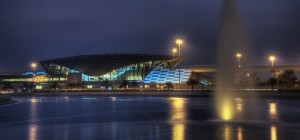By Ramola Talwar Badam www.thenational.ae
When the clock strikes midnight and the rest of Dubai is asleep, the Metro’s maintenance brigade goes into action.
 Dozens of engineers and workers check the track, fix faults inside coaches and repair train cables in the workshop. Some trains are guided into a light repair workshop and others are parked inside the Roads and Transport Authority’s (RTA) sprawling Rashidiya depot. A few trains on side tracks off the main line are already scrubbed and cleaned for the next day.
Dozens of engineers and workers check the track, fix faults inside coaches and repair train cables in the workshop. Some trains are guided into a light repair workshop and others are parked inside the Roads and Transport Authority’s (RTA) sprawling Rashidiya depot. A few trains on side tracks off the main line are already scrubbed and cleaned for the next day.
Work begins in earnest after the last train rolls out and the shutters of Metro stations shut for the night.
“When one person finishes work, someone else’s work starts,” said Ali Abdul Qader Saeed, the director of the RTA rail maintenance department. “People don’t realise how much attention must be paid to safety issues at night before the first passenger gets on the train in the morning.”
Groups of workers with orange safety vests and white helmets walk along stretches of track earmarked by the Operation Control Centre, which runs the Metro by day and sets the night work schedule. Their work starts when rail operations are halted and trains head to Rashidiya or the Jebel Ali depot at either end of the 52-kilometre Red Line.
“Every night a certain section of track is taken up and workers physically walk and check it,” said Mr Saeed about the 15-day period during which the entire track is covered. “They check for any obstruction, any abnormality on the track and in the tunnels.”
Although riders have often urged authorities to keep the trains running past midnight, Metro officials say the vital behind-the-scenes work must be completed in the small hours of the night.
“When the train is running, nobody can go on the track for maintenance,” said Ramadan Mohammed, the director of the RTA’s rail operations department. “So when we stop the railway at night we can do the replacement or technical work.”
In the Rashidiya depot, the RTA’s largest at over 174,000 sq metres, trains pull in for a quick night’s rest in an air-conditioned building that can accommodate up to 64 of the vehicles. The glow of red lights on the front coach signals that the train awaits a bit of sprucing up.
“Trains are cleaned once a day,” said a supervisor who did not want to be identified. “We have 17 or 18 people who get on board and it takes one hour per train.”
In a nearby workshop, blue ceiling lights flash and a clanging bell sounds a cautionary warning to clear the elevated tracks as an attendant guides a train into its slot. Each train is brought in every three days for a thorough two-hour inspection that includes an exhaustive checklist.
“Lights must be replaced here,” a worker informs his supervisor as he works his way through a 57-point assessment covering everything from brakes to tail lights. Other workers clamber underneath the trains and use powerful flashlights to inspect the equipment below.
“We check the exterior frame and the interior for problems,” said a supervisor who asked not to be named. “Anything we fix is explained to the next team when we hand over the train.”
Stations, too, are busy after the system shuts down, with station masters on duty through the night to clear staff ranging from attendants lining up for driving tests to contractors completing internal work.
“Nights are busier than the days,” said a station master at Union Station who wished to remain unidentified. “We authorise entry for workers, tally the day’s revenue collection and commuter numbers.”
Back at the Rashidiya depot, dozens of blue and silver trains are readied for some down time.
“We put the trains to sleep after all the checks are done,” Mr Saeed said. “They are in sleep mode because there is nothing more for them to do. They also need rest before they are woken up in the morning.”
It’s back to the grind at 5am, an hour before the Red Line opens, as so-called “sweeping trains” are sent out to confirm the tracks are safe and the Metro is ready for another day’s business.
















